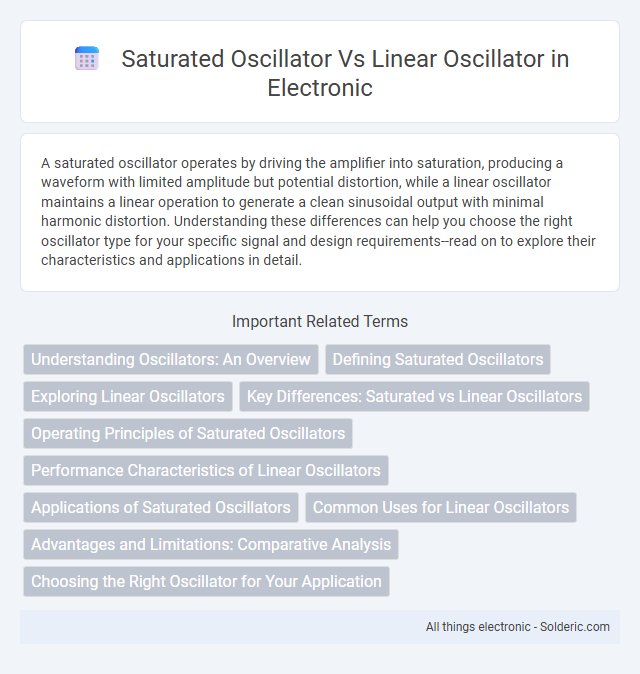A saturated oscillator operates by driving the amplifier into saturation, producing a waveform with limited amplitude but potential distortion, while a linear oscillator maintains a linear operation to generate a clean sinusoidal output with minimal harmonic distortion. Understanding these differences can help you choose the right oscillator type for your specific signal and design requirements--read on to explore their characteristics and applications in detail.
Comparison Table
| Feature | Saturated Oscillator | Linear Oscillator |
|---|---|---|
| Operation Mode | Non-linear, uses amplitude saturation | Linear region, no amplitude clipping |
| Amplitude Control | Self-limiting via saturation | Controlled by external feedback |
| Signal Waveform | Non-sinusoidal, distorted waveform | Pure sinusoidal waveform |
| Phase Noise | Higher phase noise due to non-linearity | Lower phase noise, better spectral purity |
| Amplitude Stability | Stable due to clipping effect | Stability depends on circuit design |
| Power Consumption | Typically higher due to saturation | Generally lower energy consumption |
| Applications | Digital clocks, pulse generation | RF signal generation, communication systems |
Understanding Oscillators: An Overview
Saturated oscillators operate by driving the active device into non-linear saturation, producing a stable amplitude but rich in harmonic distortion, making them ideal for applications requiring consistent output power like RF transmitters. Linear oscillators maintain the active device within its linear operating region, delivering low distortion and precise frequency control, essential for high-fidelity signal generation in communication systems. Understanding these differences helps you choose the right oscillator type based on the balance between signal purity and amplitude stability needed for your application.
Defining Saturated Oscillators
Saturated oscillators operate by driving an active device into a nonlinear region, producing a waveform with clipped or limited amplitude for stable, distortion-tolerant signals ideal in digital and clock circuits. Unlike linear oscillators, which maintain sinusoidal waveforms through small-signal linear operation and require careful amplitude control, saturated oscillators rely on saturation effects for amplitude stabilization. This approach results in robust output signals with reduced sensitivity to component variations, making saturated oscillators suitable for applications demanding stable frequency generation under varying environmental conditions.
Exploring Linear Oscillators
Linear oscillators produce a sinusoidal output that maintains a stable amplitude and frequency over time, making them ideal for precise signal generation in communication systems and instrumentation. Unlike saturated oscillators that rely on nonlinear amplification causing waveform distortion, linear oscillators use feedback networks to ensure minimal harmonic content and low phase noise. Your choice of a linear oscillator enhances signal integrity in applications demanding high spectral purity and frequency stability.
Key Differences: Saturated vs Linear Oscillators
Saturated oscillators operate by driving their active devices into saturation to produce stable amplitude signals, making them suitable for generating square waves or other non-sinusoidal outputs. Linear oscillators maintain their active elements within the linear region to produce low-distortion sinusoidal waveforms with high frequency stability. The key difference lies in the amplitude control mechanism: saturated oscillators rely on nonlinear saturation effects, whereas linear oscillators use linear feedback with amplitude stabilization.
Operating Principles of Saturated Oscillators
Saturated oscillators operate by driving the active device into saturation, creating a clipped, square-like waveform that ensures stable amplitude through nonlinear feedback. The oscillation mechanism relies on the active element switching between cutoff and saturation states, which generates harmonic-rich signals suitable for digital timing and switching applications. This contrasts with linear oscillators that maintain sinusoidal outputs by operating within the linear region of the active device, emphasizing signal purity over amplitude stability.
Performance Characteristics of Linear Oscillators
Linear oscillators exhibit stable amplitude and frequency due to their operation within the linear region of the active device, minimizing distortion and ensuring spectral purity. Their low phase noise and predictable output stability make them ideal for precision communication and measurement systems. You can rely on linear oscillators for consistent performance in environments requiring minimal harmonic generation and signal integrity.
Applications of Saturated Oscillators
Saturated oscillators are widely used in digital and switching circuit applications due to their well-defined amplitude and fast switching characteristics, making them ideal for clock generation, pulse shaping, and frequency synthesis in digital systems. Their nonlinear operation ensures stable and consistent output amplitude, which is critical in timing circuits and communication systems requiring precise signal timing and waveform stability. Unlike linear oscillators, saturated oscillators excel in applications where square or rectangular waveforms are needed rather than sinusoidal signals.
Common Uses for Linear Oscillators
Linear oscillators are commonly used in communication systems for generating stable and low-noise radio frequency signals critical in transmitters and receivers. They provide precise frequency control in measurement instruments and signal processing applications where signal fidelity and phase noise are paramount. These oscillators are also essential in phase-locked loops (PLLs) and frequency synthesizers, enabling accurate frequency generation and modulation in wireless technology and radar systems.
Advantages and Limitations: Comparative Analysis
Saturated oscillators provide stable, high-amplitude outputs with enhanced distortion resistance, making them suitable for robust signal generation in communication systems. Linear oscillators offer superior signal purity and frequency stability, ideal for precision applications like instrumentation and measurement. Your choice depends on whether amplitude stability or spectral purity is more critical for the intended electronic design.
Choosing the Right Oscillator for Your Application
Selecting the right oscillator depends on the application's frequency stability and signal purity requirements. Saturated oscillators offer robust amplitude control, ideal for power-critical applications but may introduce harmonic distortion. Linear oscillators provide cleaner output signals and better phase noise performance, suited for precision frequency generation in communication and measurement systems.
Saturated oscillator vs Linear oscillator Infographic

 solderic.com
solderic.com